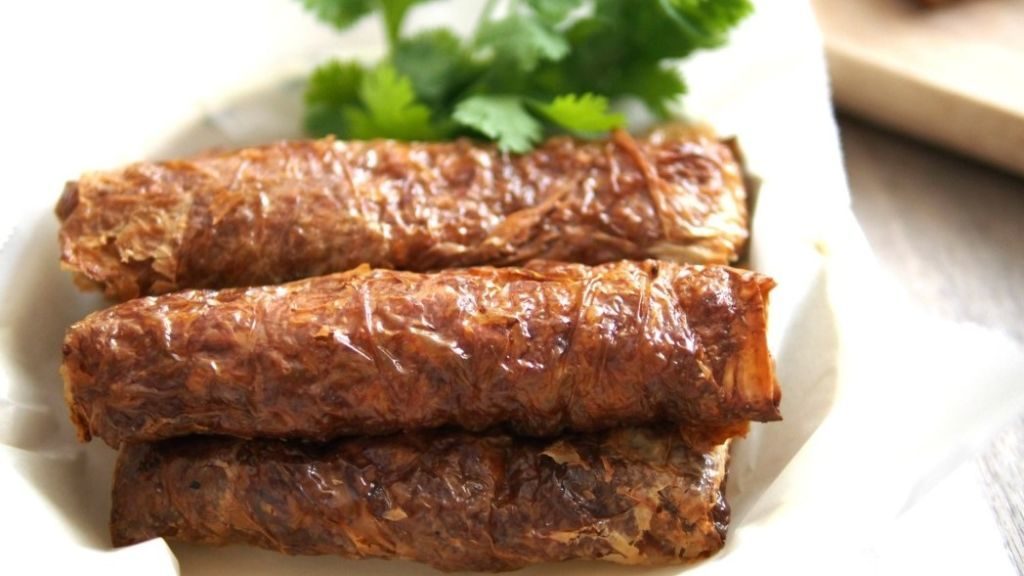A staple at the annual Chinese New Year reunion dinner, Lor Bak is a humble side dish that disappears as fast as it is laid on the table, and rightly so, thanks to its delicious meaty inside.
With origins in Fujian, China, Lor Bak – or Wu Xiang as it is sometimes called – is now mostly enjoyed by Hokkien or Teo Chew dialect groups.
What is Lor Bak?
Essentially, Lor Bak is a Chinese fried meat roll, sometimes likened to a Chinese sausage, where its fillings are mostly of minced meat with bits of fresh vegetables. These vegetables can range from cucumbers to turnips to water chestnuts, and red onions.
Altogether, the ingredients are seasoned in five-spice powder – which is what gives to its Chinese name Wu Xiang (wu meaning five). After the five-spice seasoning, the meat roll is wrapped in tofu skin and deep-fried for a crispy mouthfeel.
Each roll is roughly 5cm to 10cm in length, which is why it is consumed as a side dish or an appetiser. Generally, Chinese folks love to dip the meat roll in homemade chilli sauce for an extra zing at the end of every flavourful bite.
History of Lor Bak and Five-Spice
Much of the dish origins are lost to history except that it originated from Fujian, China. There are, however, more traces of its key ingredient that is the mighty five-spice powder.
In an attempt to recreate the ultimate all-star spice, the Chinese had the thought to combine all the five elements – wood, fire, earth, metal and water, and its representative flavours – sour, bitter, sweet, pungent and salty in one mix. The spices used are cloves, peppercorns, star anises, cinnamon, and fennel seeds.
Five-spice became so popular that it sits on every Chinese family’s spice rack as the perfect seasoning for fatty meat. To include it in the making of the dish is, of course, a no-brainer, given how the rich flavours are enhanced in the marinade.
Health Benefits
As five-spice is a powerhouse of vitamins and antioxidants, with each spice providing its benefits, it can be tempting to justify reaching for more Lor Bak. However, due to the high meat to vegetable ratio within the meat roll, it is advisable to consume it in moderation. Once every year is no harm compared to eating it once every day.
Variations
Though the dish’s origin lies in Eastern China and is typically associated with the Hokkien or Teo Chew dialect groups, other nations around Southeast Asia have also put their spin on the meat roll.
In the Philippines, for example, it was introduced by Hokkien immigrants, but it goes by the name of kikiam. Kikiam differs in its filling as it contains white fish instead.
Another adaptation of the dish which hails from Cebu is the Filipino appetiser, Ngo Hiong. Much like the original, the fillings are the same, but the tofu skin is substituted with a thin egg crepe before it goes for a deep-fry.
Subsequently, though its star ingredient is meat, there have also been vegetarian alternatives popping up in the market. The veggie option tends to use yam and taro as meat substitutes instead.
Where to Find in Malaysia
Because it’s a seasonal dish, Lor Bak isn’t as common all year round. That being said, some Chinese restaurants do serve this mouth-watering delight if you search hard enough. Save yourself to the trouble of going restaurant-to-restaurant when you can use foodpanda to speed up the process! Your next taste of this unique dish is just a click away!
Or if you’re adventurous in cooking, try making your own Lor Bak with our recipe! It will definitely be the star dish among other dishes on the table.
